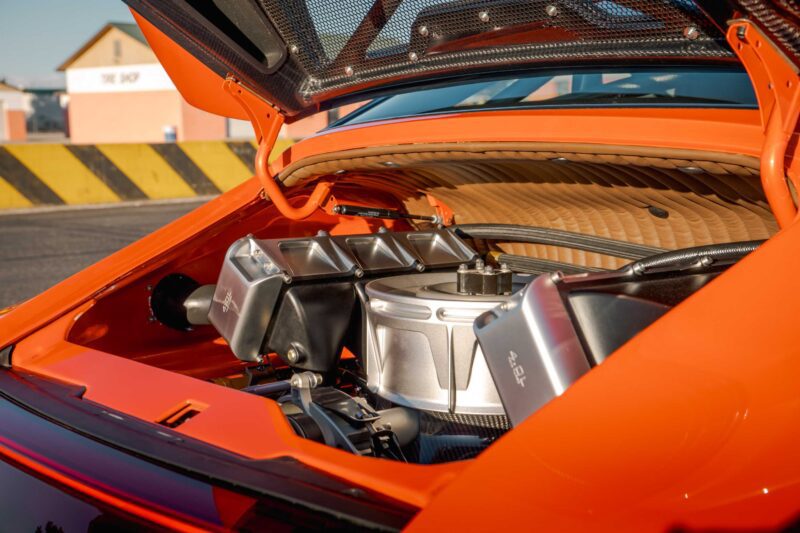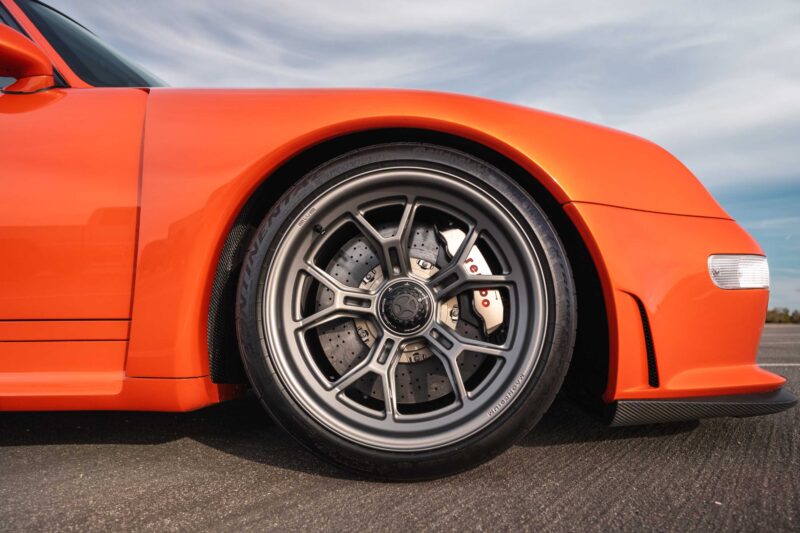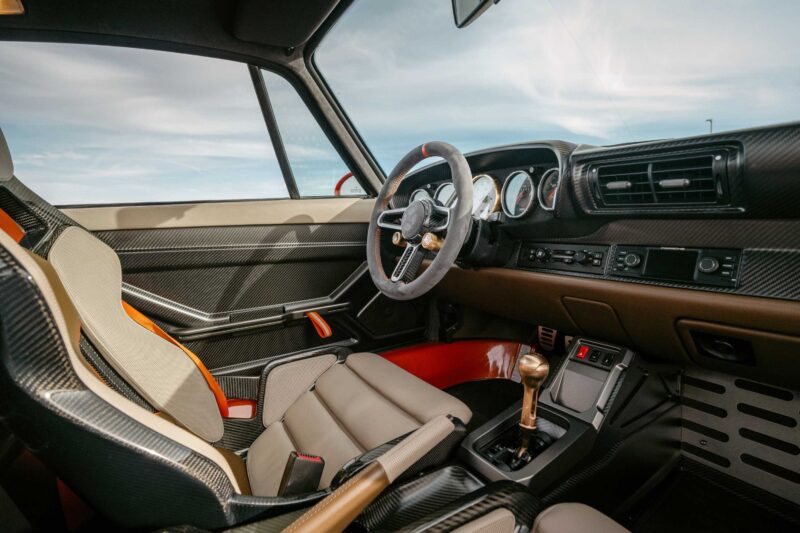Amid a swelling sea of Porsche-based restomods, each and every firm that enters the market needs to quickly establish a clear-cut identity from the get-go. Few will ever manage to turn heads from the jump as well as Gunther Werks, which burst onto the scene in 2018 with a radical take on the quintessential 911 sports car as envisioned by Vorsteiner Wheels founder and CEO Peter Lam.
I recently visited Gunther Werks’ headquarters in Southern California, legitimately curious to learn whether Porsche performance can ever match such an aggressive level of creative license and custom craftsmanship. And even a single day with the latest and greatest model, dubbed simply the Turbo and first unveiled at The Quail, A Motorsports Gathering almost a year ago, completely quelled any lingering doubts about Gunther Werks being gun-shy when push comes to shove in the Porsche restomod scene.
What Sets Gunther Werks Apart

As with Gunther’s previous Coupe (formerly known as the 400R) and Speedster, each Turbo starts with a client’s 993-generation 911 as a donor car. Ideally, a Carrera 2 (though a Carrera 4 will also work), these last of the air-cooled Porsches were still built by hand in Zuffenhausen before Porsche transitioned to true mass production methods for the 996-generation successor.
Gunther then strips, blasts, and restores the chassis underpinnings before bolting on additional bracing front, mid, and aft. The resulting monocoque now boasts 150% improved torsional rigidity, and then receives carbon-fiber body panels and a complete overhaul down to the last detail inside.
Apart from the immediacy of such bold exterior styling, up close and personal, the Turbo reveals truly impressive levels of attention: from the knurled metal switchgear to bezels in the headlight surrounds that resemble track safety tape. Some of the old-school luxury details, including 24-carat gold for the tachometer trim, contrast nicely against all the overtly modern carbon fiber, the PCCM head unit with Apple CarPlay, and the JRZ suspension that can be adjusted through a smartphone app.


But the true star of the show hangs off the rear axle, a Rothsport Racing 4.0-liter flat-six built to handle dual 48-millimeter Garrett turbochargers. Skipping out on bigger turbos purposefully maintains crisp throttle response, yet these produce enough boost that even in the mill’s Comfort setting, the Turbo can crank out an absurd 513 horsepower and 458 lb-ft of torque. That’s nearly AMG GT power, which requires twin-turbos for a water-cooled V8, in a rear-engined car that weighs almost exactly 1,500 pounds less.
Sport then steps up a notch to 650 hp and 518 lb-ft, and the top Track mode climaxes at an absurd 840 hp and 594 lb-ft. Controlled via a six-speed manual shifter with zero traction or stability control assist, no less. And the shifter itself demands some attention, with sculptural exposed linkages clearly visible inside the transmission tunnel.
I palmed the metal knob and met a bit of resistance the first time I slotted the short throw into first gear, but each step through the H-pattern greeted my hand with a satisfying thunk as I ripped through short gear ratios that Gunther purposefully retained to highlight the engine’s rev-happy nature.
Along the way, that 4.0-liter’s soundtrack truly eclipses any other car I’ve ever seen, heard, or driven. Air-cooled rasp and turbo whine and a massive gear-driven horizontal fan all work together in a mind-melting cacophony, even at idle. I sensed violence contained within such beautiful physical form, yet the first few minutes of driving in Comfort mode revealed an almost benign sense of calm capability, too.
Adjusting to Increasingly Powerful Drive Modes


I started out tooling around town, enjoying little quarter-throttle pulls and each shift without ever venturing too far into the tachometer. Playing nicely, the throttle never seemed touchy or twitchy, which helped to keep my nerves at bay as I piloted something so obviously raring to rumble. Then I spun the steering wheel’s right-hand dial to Sport, which promptly unleashed noticeably more surging grunt, as instantaneously accessible wellsprings of torque became available even below 2,000 rpm.
Track mode then dives even further into the deep end, with unrelenting power available at every lightest touch of the go pedal. The time soon came to enjoy each and every rev on the way to the 7,800-rpm redline, as the Rothsport engine ripsawed up through the tach and the brute force shoved me back into the surprisingly comfortable carbon-fiber bucket seats (a serious improvement over Porsche’s current crop of buckets, which seem inspired by airliner coach seats).
All the while, the Turbo enjoyed nudging deeper into corners, and I sensed the chassis loading up each individual tire with grip, which only lent more confidence as I unwound the steering wheel while the tail end squatted under the unrelenting shove of swelling boost, until that blattering banshee of an engine dominated all my sensory perception once again.
Custom Touches to Match the Driving Thrills

Yet still, I never stepped over the limit without asking the Turbo to break the rules of physics. Wide tires likely bear some responsibility for the impressive driveability: Continental ExtremeContact Sport 02 rubber measuring 295 millimeters wide up front and 335 at the rear retains enough compliance to provide grip without getting too stiff. Same for the JRZ suspension, which works in perfect harmony with the steering – the former electronically adjustable and the latter still hydraulic, for predictable levels of feedback.
Just don’t ever look down at the speedometer, which Porsche mounts to the right of the tach for good reason. Triple digits fly by almost too fast for public roads – luckily, so much stopping power from Brembo continuous-thread carbon ceramic brakes can haul down that kind of speed with ease. Once again, the artful performance from every aspect, rather than simply shoehorning big power into a light car, inspired far more confidence than I expected from the onset.


The whole point, for Gunther Werks, is to enhance the engagement factor that so many modern supercars and hypercars struggle to achieve despite – or, arguably, because of – such impressive technological advancements at the far end of today’s computerized age. But a similar priority placed on individualization figures into the mix, too. This car’s bright and bold orange paint, with a contrasting leather interior, serves as perfect fodder for marketing pics. A Turbo can easily inhabit a more restrained character, too, in keeping with the classic understatement of the air-cooled 911. Especially when specced with a smaller spoiler and darker hues.
Most colors that Gunther Werks applies (on site with two paint rooms) wind up fully custom, known only by the client’s last name rather than a particular moniker. Similarly, no two cars will ever wind up identical, especially given the number of interior options that run from leather dash plates to carbon-fiber everything, a Travel Package transmission tunnel with a built-in cell phone mount, and even the steering wheel’s dish depth.
I truly appreciated the magnetic removable headrest pads for track days, which aren’t about saving weight per se but rather to make room for a helmet. And despite the custom rollcage, at six-foot-one I fit just fine thanks to the Turbo’s double bubble, with or without a helmet on.
Gunther Werks Turbo: Conclusions

Of course, tracking a Turbo requires a certain level of confidence that I’d need to build up over time. Pricing for the Gunther Werks Turbo starts at $1.45 million, but as specced, my test car ran up to $1.8 million.
A full build requires about 24 months from the time Gunther receives the donor car, including time spent guiding clients through color and material options. Only 75 Turbos will ever join the 25 Coupes and Speedsters at the most raucous end of the restomod scene, where the final product reaches an entirely different result from a 911 as reimagined by Singer – and not just because Singer originated with 964-based creations.
At the other end of the spectrum sits the completely new cars built by Ruf in Pfaffenhausen, which just happen to resemble the classic 911 that originally inspired all these companies to leap headlong into the restomod craze. Retaining some semblances of 911-ness therefore, becomes the name of the game, even as power and aesthetics and materials leapfrog forward into the modern era.
In that regard, the Turbo still at least vogues the 911 on which it is based. I might want another, softer suspension mode to choose, since the large front wheels can tramline occasionally and the lightweight body panels do increase some interior reverberations. But admittedly, softening up a Gunther Werks might also miss the mark. And after driving such a stupefying creation, I struggle to imagine how Gunther Werks can possibly hope to one-up a build so impressive at The Quail, A Motorsport Gathering later this year.

